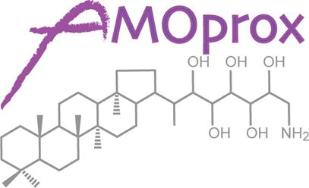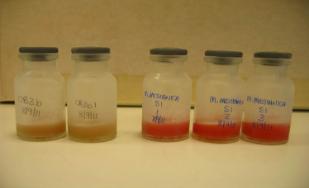AMOProx
Quantifying Aerobic Methane Oxidation in the Ocean: Calibration and palaeo application of a novel proxy (ERC grant agreement 258734)
PI. Dr Helen Talbot
RAs. Dr Darci Rush, Dr Angela Sherry
PhD Students. Kate Osborne, Charlotte Spencer-Jones
Research Technician. Frances Sidgwick


Summary
Methane is a key greenhouse gas and its release to the atmosphere is modulated microbially by two pathways; an aerobic and an anaerobic pathway. Research on the marine methane cycle has focussed on anaerobic processes but recent biomarker data has provided compelling evidence that aerobic methane oxidation (AMO) may play a much more significant role in reducing the amount of methane emitted from sediments than previously considered. AMO in these settings is poorly understood and a more complete understanding of present and past methane fluxes requires novel proxies that can be applied to present days samples and linked to the sedimentary record. This study fills this gap by targeting complex lipids biosynthesised by aerobic methanotrophs known as aminobacteriohopanepolyols (BHPs). Recently BHPs have been identified in a wide range of modern and recent environments including a continuous record from the Congo deep sea fan spanning the last 1.2 million years.
In this integrated study, the regulation and expression of BHP will be investigated and calibrated against environmental variables including temperature, pH, salinity and, most importantly, methane concentrations and fluxes to identify markers that correlate BHP concentration and composition with environmental conditions. These will then be used to evaluate palaeoenvironmental conditions in relation to methane cycling in the sedimentary record. The work program has three complementary strands: (1) Analysis of BHPs systematically in pure culture and sediment microcosm experiments providing an approximation to natural conditions; (2) calibration of BHP signatures in natural marine settings (e.g. cold seeps, mud volcanoes, pockmarks) against measured methane gradients and (3) application of this novel approach to the marine sedimentary record to approximate methane fluxes in the past, explore the age and bathymetric limits of this novel molecular proxy, and identify and 14C date palaeo-pockmarks structures. Accurate and sensitive quantitative analysis of BHPs is vital to these goals and development of methods with a new triple-quadrupole mass spectrometer will be an essential component of the programme.
SELECTED POSTERS:
Anammox bacteria and BHT isomer
PUBLICATIONS
Kool, D.M., Talbot, H.M., Rush, D., Ettwig, K., Sinninghe Damsté, J.S., 2014. Rare bacteriohopanepolyols as markers for an autotrophic, intra-aerobic methanotroph. Geochimica et Cosmochimica Acta 136, 114-125.
Rush, D., Sinninghe Damsté, J.S., Poulton, S.W., Thamdrup, B., Garside, A.L., Acuña González, J., Schouten, S., Jetten, M.S.M., Talbot, H.M., 2014. Anaerobic ammonium-oxidising bacteria: the only known biological source of the bacteriohopanetetrol stereoisomer in marine sediments. Geochimica et Cosmochimica Acta 140, 50-64.
Talbot, H.M., Handley, L., Spencer-Jones, C.L., Dinga, B.J., Schefuß E., Mann, P.J., Poulsen, J.R., Spencer, R.G.M., Wabakanghanzi, J.N., Wagner, T., 2014. Variability in aerobic methane oxidation over the past 1.2 Myrs recorded in microbial biomarker signatures from Congo fan sediments. Geochimica et Cosmochimica Acta 133, 387-401.
Wagner, T., Kallweit, W., Talbot, H.M., Mollenhauer, G., Boom, A., Zabel, M., 2014. Microbial biomarkers support organic carbon transport from Amazon wetlands to the shelf and deep fan during recent and glacial climate conditions. Organic Geochemistry 67, 85-98.